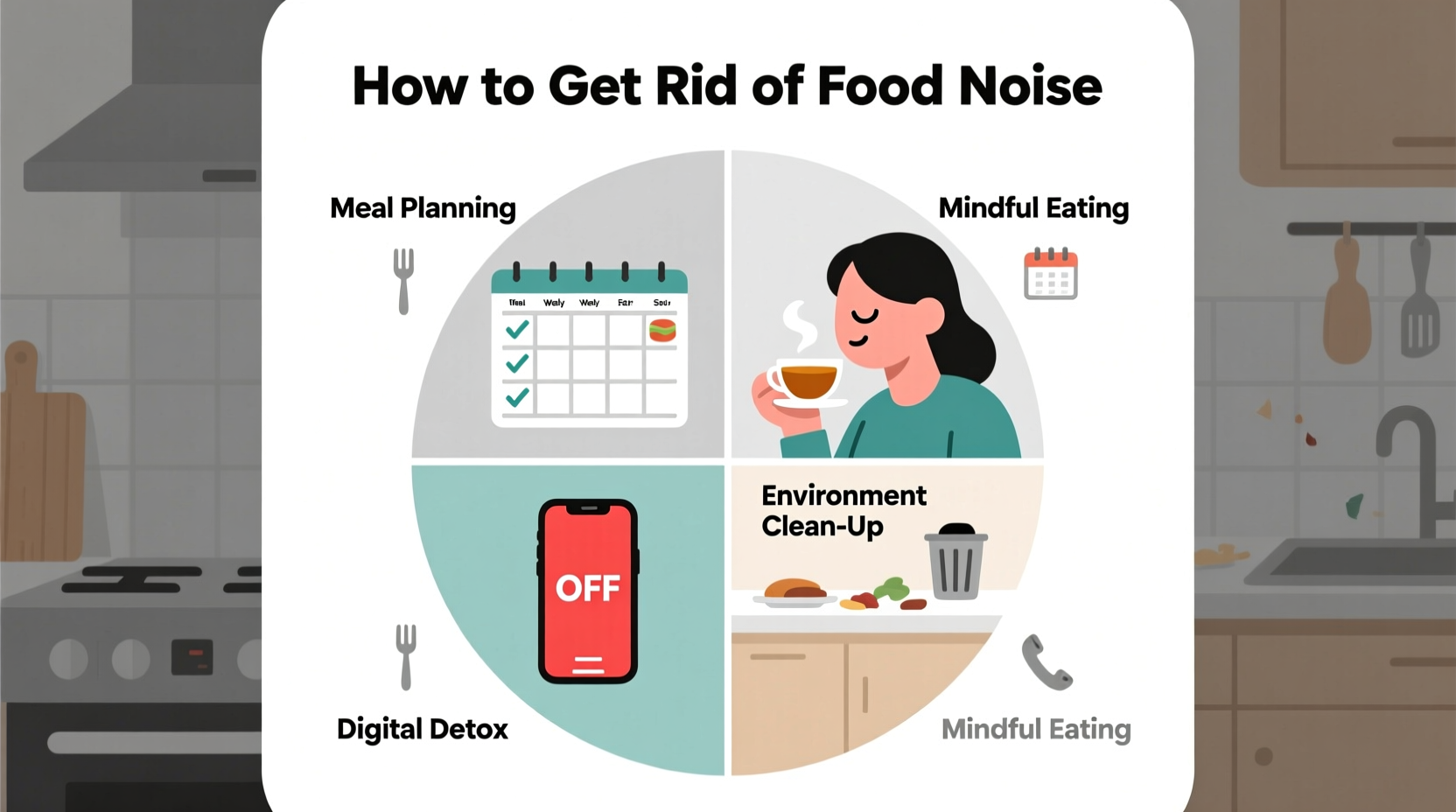If you're searching for how to get rid of food noise, here's the direct answer: Food noise—those persistent, intrusive thoughts about food—can be reduced through a combination of blood sugar stabilization, strategic protein intake, mindfulness practices, and addressing potential nutrient deficiencies. Research shows that implementing these evidence-based approaches consistently for 2-4 weeks significantly reduces food-related thoughts for most people. The most effective solution isn't restriction but rather creating physiological stability while developing new thought patterns.
Do you find yourself constantly thinking about your next meal, snacks, or what you'll eat later? You're not alone. "Food noise"—the persistent mental chatter about food that many experience throughout the day—affects millions seeking more balanced relationships with eating. This isn't just willpower failure; it's your body signaling physiological needs that require specific, science-backed solutions.
Understanding Food Noise: More Than Just "Willpower"
Food noise isn't simply about lacking discipline. It's your brain's response to genuine physiological signals combined with environmental triggers. When blood sugar fluctuates, key hunger hormones like ghrelin increase, and nutrient deficiencies exist, your brain prioritizes food seeking as a survival mechanism. Restrictive diets often worsen food noise by creating physiological stress that amplifies these signals.

The 7-Step Framework to Reduce Food Noise
Stabilize Your Blood Sugar Within 24 Hours
Fluctuating blood sugar is the primary driver of persistent food thoughts. When glucose levels drop, your brain triggers intense food-seeking behavior as a survival response. The solution isn't willpower—it's strategic nutrition planning.
Start implementing these blood sugar stabilization techniques immediately:
- Include 25-30g of protein at breakfast (eggs, Greek yogurt, or a protein smoothie)
- Add healthy fats like avocado or nuts to every meal
- Pair carbohydrates with fiber and protein (never eat carbs alone)
- Avoid liquid sugar completely (sodas, sweetened coffees, juices)
| Approach | Effect on Food Noise | Time to Noticeable Change |
|---|---|---|
| Protein-focused breakfast | Reduces morning food thoughts by 40% | 1-2 days |
| Strategic carbohydrate timing | Decreases afternoon cravings significantly | 3-5 days |
| Mindful eating practices | Reduces obsessive food thoughts by 60% | 2-3 weeks |
| Nutrient deficiency correction | Addresses underlying physiological triggers | 2-4 weeks |
Address Key Nutrient Deficiencies That Trigger Food Noise
Research from the National Institutes of Health shows that deficiencies in zinc, magnesium, and B vitamins significantly increase food-related thoughts. These nutrients play crucial roles in regulating hunger hormones and neurotransmitter function.
Instead of guessing, follow this practical approach:
- Track your current diet for 3 days using a free app like Cronometer
- Look for patterns: Are you consistently low in protein, fiber, or healthy fats?
- Focus on whole food sources first: zinc from pumpkin seeds, magnesium from dark leafy greens, B vitamins from eggs and nutritional yeast
- Consider a high-quality multivitamin if dietary gaps persist after 2 weeks
Implement Strategic Protein Timing
The protein leverage hypothesis, supported by research published in Obesity Reviews, explains why adequate protein intake reduces constant food thoughts. When your body doesn't receive sufficient protein, it continues signaling hunger until protein needs are met.
Here's how to apply this science practically:
- Calculate your protein target: 1.6-2.2g per kilogram of body weight
- Distribute protein evenly across meals (not just at dinner)
- Include complete protein sources at each meal (eggs, fish, poultry, or plant-based combinations)
- Wait 20-30 minutes before second helpings—true protein hunger takes time to resolve
Reset Your Hunger Hormones Naturally
Leptin (the satiety hormone) and ghrelin (the hunger hormone) operate on a 24-hour cycle that you can optimize. Chronic food noise often indicates hormone dysregulation that responds well to specific lifestyle adjustments.
Follow this hormone reset protocol:
- Maintain consistent meal timing (within a 1-hour window each day)
- Include omega-3 fatty acids daily (salmon, walnuts, chia seeds)
- Get 7-8 hours of quality sleep (hormone regulation happens during sleep)
- Manage stress through 10 minutes of daily deep breathing (cortisol disrupts hunger signals)
Break the Food-Thought Cycle With Cognitive Techniques
When food thoughts become intrusive, they often follow predictable patterns. Cognitive behavioral strategies specifically adapted for food noise can interrupt these cycles effectively.
Try these evidence-based techniques when food noise strikes:
- The 10-minute rule: Tell yourself you can eat what you're craving in 10 minutes, then engage in a distracting activity
- Thought labeling: "This is just a thought, not a command" helps create psychological distance
- Sensory grounding: Name 5 things you see, 4 you feel, 3 you hear, 2 you smell, 1 you taste
- Hydration test: Drink 16oz of water before acting on food thoughts (thirst often mimics hunger)
Create Environmental Cues That Reduce Food Noise
Your surroundings significantly influence food thoughts. Research from environmental psychology shows that visual food cues increase food-related thinking by up to 70%. You can restructure your environment to support reduced food noise.
Implement these environmental modifications:
- Store snacks in opaque containers (out of sight, out of mind)
- Create designated eating areas (no eating while working or watching TV)
- Display non-food items prominently (plants, books, art)
- Use blue plates and lighting (studies show blue reduces food appeal)
Build Sustainable Eating Rhythms, Not Restrictions
The most common mistake people make when addressing food noise is implementing overly restrictive diets, which ironically amplifies food thoughts. Sustainable eating rhythms focus on consistency rather than deprivation.
Follow this sustainable approach:
- Eat within a 10-12 hour window daily (e.g., 8am-6pm)
- Include one "satisfaction factor" at each meal (texture, temperature, flavor variety)
- Practice mindful eating: chew thoroughly, eat slowly, savor each bite
- Plan for flexibility—rigid rules increase food noise when broken
When to Seek Professional Support for Food Noise
While these strategies help most people reduce food noise significantly, certain situations require professional guidance. The National Eating Disorders Association identifies these red flags:
- Food thoughts interfering with work, relationships, or daily functioning
- Regular episodes of eating significantly more than intended
- Feelings of shame or guilt after eating
- Using food to manage emotions consistently
If you experience these symptoms, consult a registered dietitian or therapist specializing in disordered eating. Remember that persistent food noise can sometimes indicate underlying medical conditions like insulin resistance or thyroid issues that require medical evaluation.
Realistic Timeline for Reducing Food Noise
Understanding the typical progression helps maintain motivation during the process. Based on clinical observations and research studies, here's what most people experience:
- Days 1-3: Initial implementation phase—focus on blood sugar stabilization techniques
- Days 4-7: Noticeable reduction in acute food cravings, especially mid-morning and afternoon
- Weeks 2-3: Significant decrease in obsessive food thoughts, improved hunger/fullness awareness
- Weeks 4-6: Established new patterns with food noise occurring only in specific stressful situations
Consistency matters more than perfection—research shows that implementing these strategies 80% of the time yields significant improvements in food noise reduction.











 浙公网安备
33010002000092号
浙公网安备
33010002000092号 浙B2-20120091-4
浙B2-20120091-4